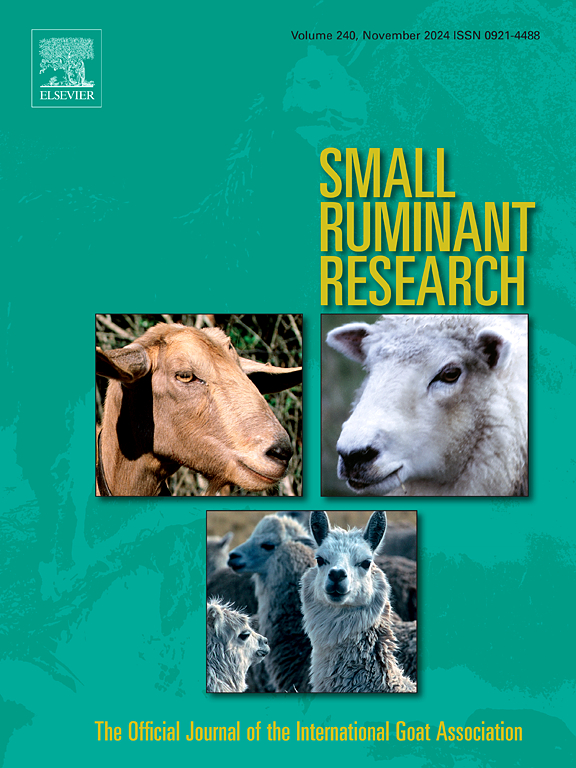Breed and shearing effects on milk composition and rennet-induced coagulation properties in dairy ewes
IF 1.6
3区 农林科学
Q2 AGRICULTURE, DAIRY & ANIMAL SCIENCE
引用次数: 0
Abstract
Shearing during late-pregnancy and mid-lactation has been proposed as improving welfare practices in dairy sheep. With this aim, and as a follow up of a previous experiment, milk composition and milk rennet-induced coagulation properties were assessed in 2 breeds of dairy ewes (Manchega, MN, n = 43; Lacaune, LC, n = 28) which were shorn at different moments of their production cycle: i) unshorn (CO), ii) shorn before breeding (SBB), or iii) shorn at d 100 of pregnancy (S100). Individual milk samples were collected at d 160 and 161 of lactation and composited for milk analyses and milk batches produced by breed and shearing treatment for assessing milk rennet-induced coagulation properties with an Optigraph laboratory instrument (rennet coagulation time, RCT; Curd firmness at 45 min, F45). Milk composition and cheese rennet-induced coagulation properties varied markedly by breed, the MN showing greater values than the LC ewes, but no differences in major milk components nor in rennet-induced coagulation properties were detected by effect of shearing in both breeds. Nevertheless, opposite differences by shearing treatment were detected in RCT, which was longer in MN (9 %) and shorter in LC (− 8 %), when S100 and CO treatments were compared. The obtained results showed marked differences in cheese extract and yield in favor to the richer MN milk, with economic consequences on milk price, whereas shearing moment only modified RCT, the sense of variation depending on the breed and not being associated to changes in milk composition; therefore, assessment of additional factors is required for in-depth understanding.
品种和剪切对奶羊乳成分和凝血酶诱导凝血特性的影响
在妊娠晚期和哺乳期中期剪羊毛被认为是改善奶牛福利的做法。为此目的,并作为先前实验的后续,对2个奶羊品种(Manchega, MN, n = 43;laacaune, LC, n = 28),它们在不同的生产周期时刻被剪短:i)未剪短(CO), ii)繁殖前剪短(SBB), iii)妊娠第100天剪短(S100)。在哺乳期第160天和第161天收集牛奶样品,并将其组合用于牛奶分析和按品种和剪切处理生产的牛奶批次,使用Optigraph实验室仪器(凝血时间,随机对照试验;凝乳硬度在45 min, F45)。乳成分和奶酪凝血酶特性因品种而异,MN值高于LC母羊,但两种母羊的主要乳成分和凝血酶特性在剪切作用下均无差异。然而,在RCT中检测到剪切处理的相反差异,当比较S100和CO处理时,MN处理的差异更长(9 %),LC处理的差异更短(- 8 %)。所得结果表明,在奶酪提取物和产量方面存在显著差异,有利于MN含量较高的牛奶,并对牛奶价格产生经济影响,而剪切力矩仅改变了RCT,变化感取决于品种,与牛奶成分的变化无关;因此,为了深入理解,需要评估其他因素。
本文章由计算机程序翻译,如有差异,请以英文原文为准。
求助全文
约1分钟内获得全文
求助全文
来源期刊

Small Ruminant Research
农林科学-奶制品与动物科学
CiteScore
3.10
自引率
11.10%
发文量
210
审稿时长
12.5 weeks
期刊介绍:
Small Ruminant Research publishes original, basic and applied research articles, technical notes, and review articles on research relating to goats, sheep, deer, the New World camelids llama, alpaca, vicuna and guanaco, and the Old World camels.
Topics covered include nutrition, physiology, anatomy, genetics, microbiology, ethology, product technology, socio-economics, management, sustainability and environment, veterinary medicine and husbandry engineering.
 求助内容:
求助内容: 应助结果提醒方式:
应助结果提醒方式:


